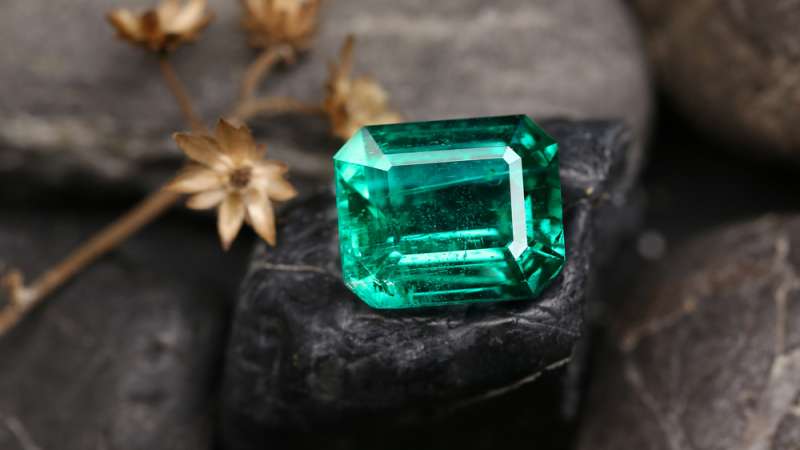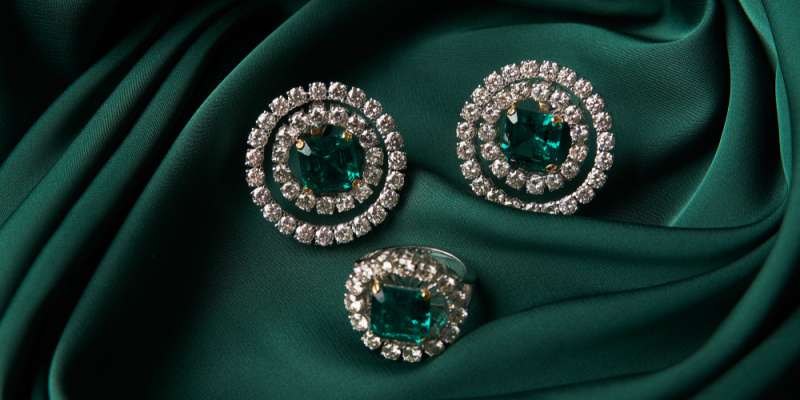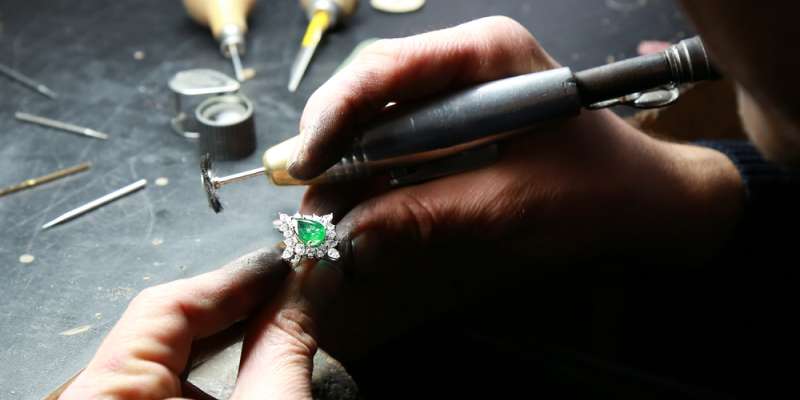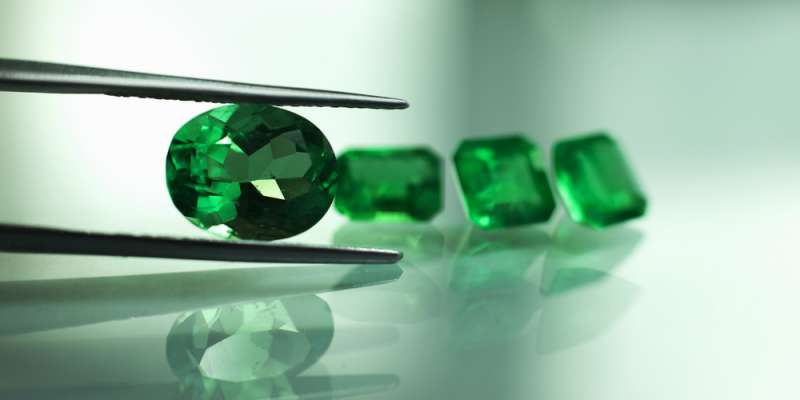Emeralds and emerald-cut diamonds are often mistaken for each other, and while the emerald cut was originally created for emeralds, it has become popular for other gemstones, including diamonds.
It’s important to recognize that emeralds and diamonds are distinct gemstones with notable differences in color, value, and other characteristics.
If you’re struggling to choose between diamonds and emeralds, we’re here to assist you. Keep reading to discover the perfect choice for you!
DESIGN YOUR OWN ENGAGEMENT RING: START WITH A SETTING OR START WITH A DIAMOND. IT’S REALLY UP TO YOU!

Diamonds Vs. Emeralds: An In-Depth Comparison
Deciding between diamonds and emeralds can be a challenging task. These gemstones have their own unique qualities and can enhance your overall appearance.
Beyond their physical appearance, diamonds and emeralds differ in several aspects, and we’ll delve into the details of each. Let’s explore further!
Color
One noticeable distinction between diamonds and emeralds is their color.
Diamonds can range from colorless to having a slight white or yellowish tint, depending on their position on the color scale. In contrast, emeralds typically exhibit a deep green to slightly blue hue. The vivid green color of emeralds is so iconic that it is often used to describe objects with a similar shade.
Emeralds derive their color from chromium and vanadium elements, which impart the distinct green hue. While some diamonds may possess a subtle green tint, they should not be mistaken for emeralds. It’s important to note that emeralds must exhibit a deep green color to be considered genuine. Although green diamonds exist, they are quite rare, and distinguishing them from emeralds can be challenging.
Color plays a crucial role in the value of both diamonds and emeralds. The more desirable and vivid the color, the higher the price of the gemstone. This principle applies to all gemstones in general. In the case of diamonds, color grading significantly affects their value. Opting for GIA-graded diamonds ensures that you’re acquiring a stone of genuine worth.
Selecting an exceptional emerald can be more nuanced, as their color grading follows a different system. Very green emeralds hold greater value, so if you find it difficult to choose, prioritize deep green shades over lighter ones.
In conclusion, color is a vital factor to consider when purchasing gemstones, and understanding the specific color requirements and grading systems for diamonds and emeralds is crucial in making an informed decision.

The Sparkle
When one thinks of diamonds, their signature sparkle is likely the first thing that comes to mind. Emeralds, on the other hand, are renowned for their bright green (sometimes slightly bluish) color.
While all gemstones possess a subtle sparkle, diamonds excel in this category due to their surface characteristics. Emeralds, in comparison, have a more subdued glimmer when exposed to direct light.
If an emerald appears unusually sparkly, it usually indicates lower quality. Conversely, with diamonds, a better sparkle is a sign of exceptional clarity, good color, and an excellent cut.
Skilled jewelers know how to enhance the sparkle in diamonds, and their craftsmanship is factored into the price. If you desire a piece of jewelry with a brilliant shine, diamonds will deliver a far superior sparkle compared to emeralds.
Here, we can also discuss brilliance, which is graded on the refractive index (RI) scale. The RI scale measures how much and how well a gemstone reflects light. Diamonds generally have a high refractive index, averaging around 2.4, while emeralds have an average RI of 1.58.
Diamonds with high brilliance are relatively common, whereas emeralds with exceptional luster are rare. Therefore, if you seek exceptional brilliance and rarity, emeralds may be your preferred choice. In summary, remarkable shine and sparkle are more readily found in diamonds than in emeralds.
Pricing
Diamonds are commonly perceived as the most expensive gemstone, although this is not always the case. While diamonds can be less expensive than emeralds in certain instances, they generally carry a higher price tag.
For diamonds with lower color and clarity grades, the price may be lower than that of an emerald. However, a pure emerald stone with the same carat weight will generally cost more than a poorly graded diamond.
Of course, this assumes the emerald in question is of high quality. Heavily included emeralds do not fare well compared to diamonds. Emeralds with numerous or large inclusions are typically more affordable due to their increased fragility and susceptibility to breakage.
Therefore, price depends on the quality in both cases, but the costs can be quite similar for both diamonds and emeralds. While diamonds are generally more in demand, the rarity of emeralds contributes to their relatively higher price. Emeralds are particularly challenging to find in nature, with Colombia being the primary source of emeralds worldwide.
However, it is essential to note that diamonds are generally more expensive. They remain highly sought after, often adorning engagement rings and other significant jewelry pieces.
Are Emeralds More Valuable Due to Rarity?
Determining which gemstone is more valuable can be a challenging task. Diamonds and emeralds are primarily used in luxurious jewelry and similar contexts.
While many gemstone enthusiasts argue that diamonds hold more value than emeralds, this is not necessarily true. Ultimately, personal preferences play a significant role in determining value rather than objective criteria.
If we equate value to the price of each gem, then diamonds can be considered more expensive. However, beyond their retail prices, both diamonds and emeralds possess immense value in their own unique ways.
Inclusions
Inclusions are another aspect where diamonds and emeralds differ significantly. Inclusions refer to tiny imperfections, cuts, and natural defects found in gemstones.
Diamonds and emeralds have contrasting tendencies when it comes to inclusions. Emeralds typically exhibit more inclusions, and it is nearly impossible to find an emerald without significant inclusions. Many of these imperfections may even be visible to the naked eye, although they are not as detrimental to emeralds as they are to diamonds.
The presence of stains, cloudiness,

What Is A Better Choice – Diamonds Or Emeralds?
Choosing between diamonds and emeralds depends on the occasion and personal preference. Both gemstones require the right event and outfit to truly shine.
For daytime events, diamonds are often the better choice. They don’t overshadow your attire and their colorlessness allows them to sparkle subtly in daylight, complementing your ensemble.
On the other hand, emeralds are perfect for evening wear. Their vibrant color might be too attention-grabbing for daytime events, but it adds a captivating touch to evening attire.
If you’re seeking a gemstone for daytime wear, diamonds are a safe bet. Look for beautiful yet discreet diamonds, as large stones on engagement rings might convey a different impression. Small diamonds can enhance a professional and polished look for work events.
If you’re still unsure, diamonds are a versatile option for both daily wear and formal occasions. Their colorless nature complements any outfit, while the vivid green of emeralds may limit your choices to specific colors and styles.
Alternatively, why not combine both gemstones? You can incorporate an emerald as the center stone and surround it with smaller diamonds, creating a unique and captivating piece of jewelry.

Bottom Line
Ultimately, deciding between diamonds and emeralds can be a truly difficult task. These gemstones are distinct from each other, despite both being rare and valuable.
Diamonds hold the advantage in terms of hardness on the Mohs scale, while emeralds can possess more inclusions and imperfections without diminishing their value. Diamonds are often seen as “more perfect,” whereas the unique character of emeralds lies in their imperfections.
In terms of versatility, diamonds excel as they can be worn for any occasion. However, if you desire a gemstone piece specifically for special events, emeralds make an excellent choice.


